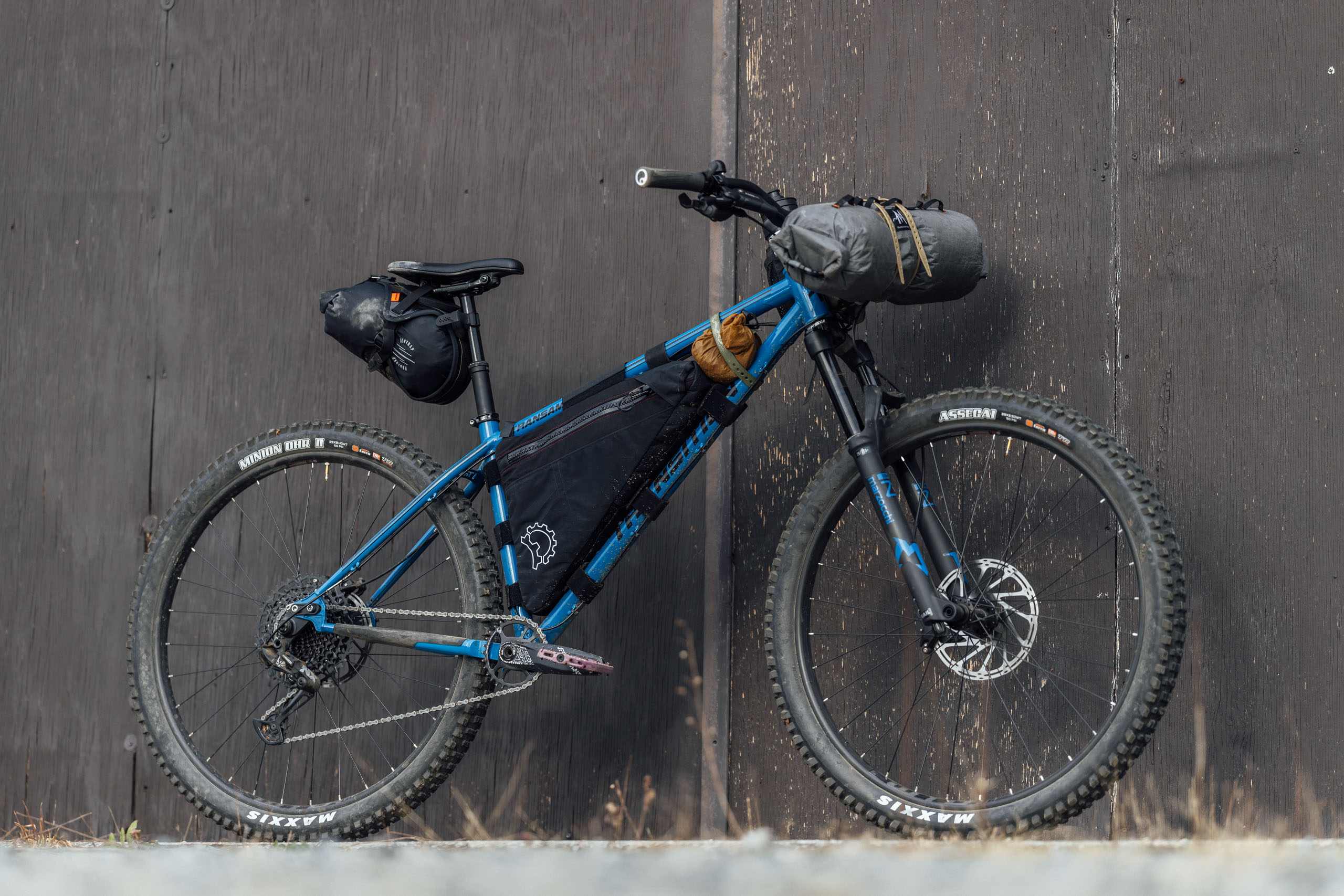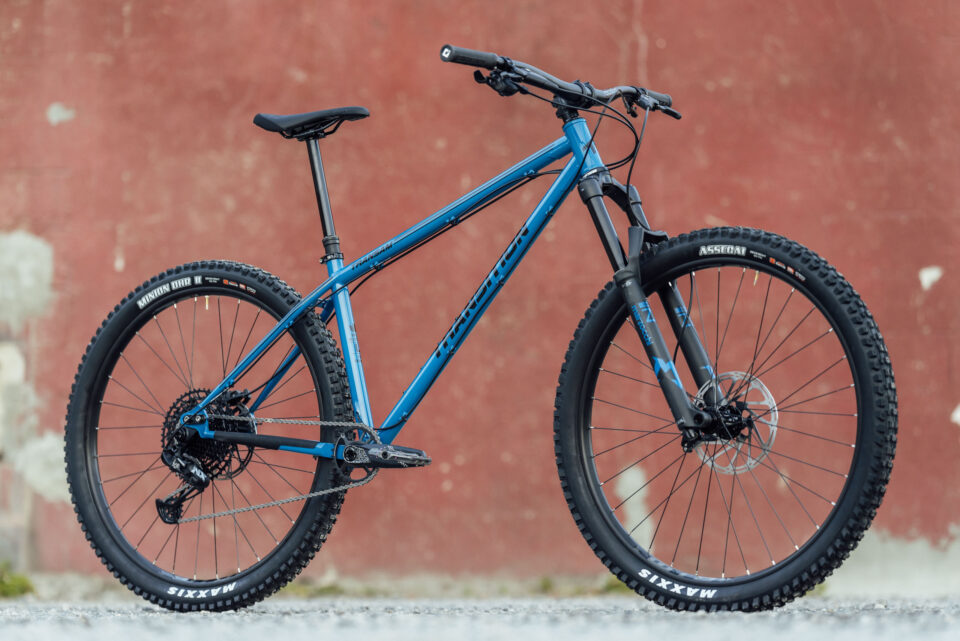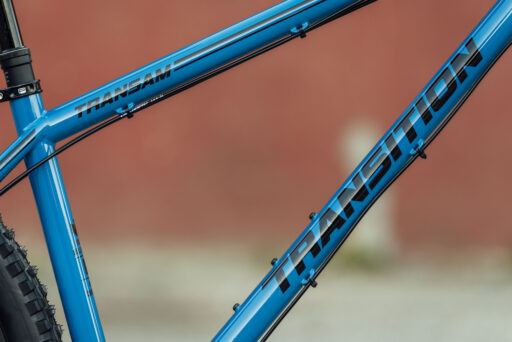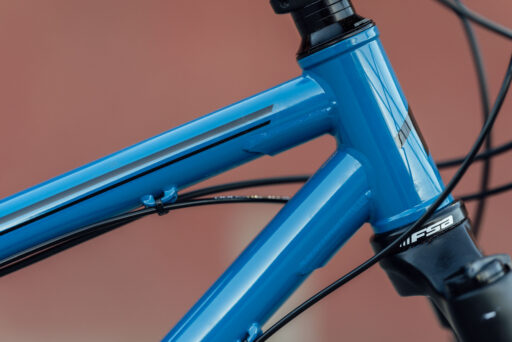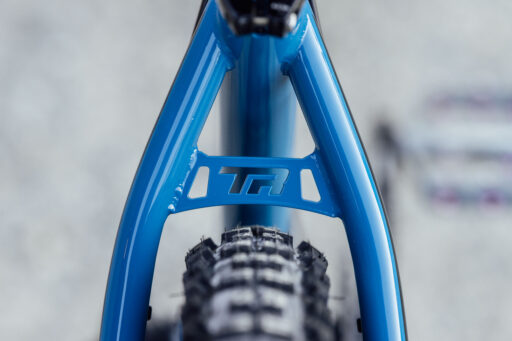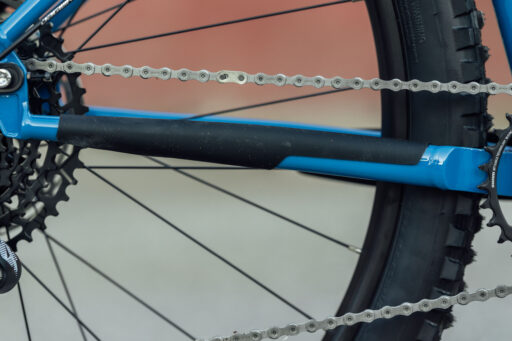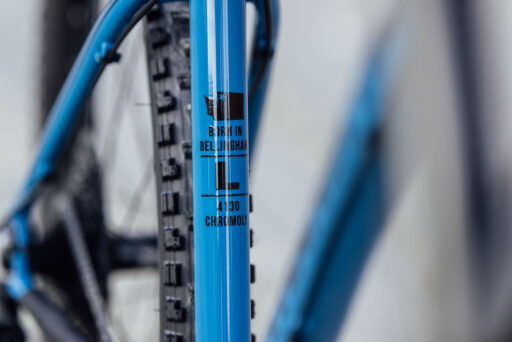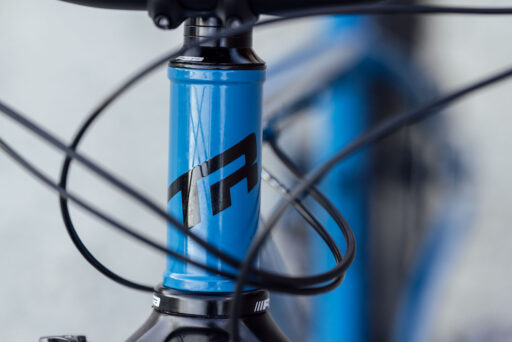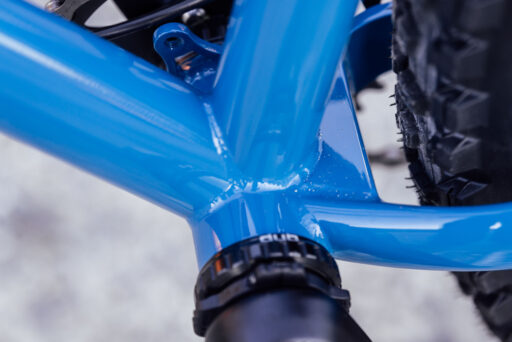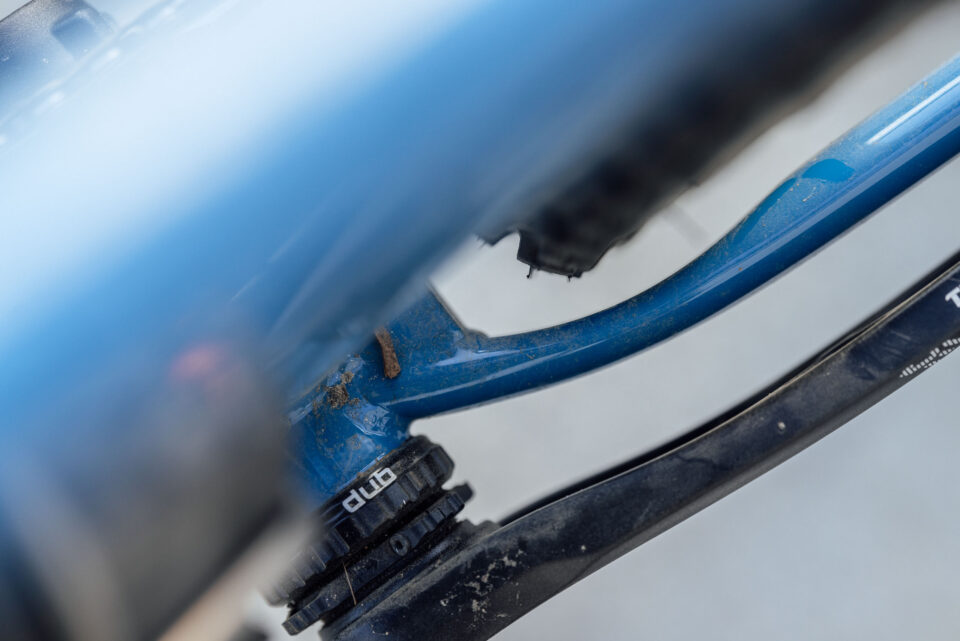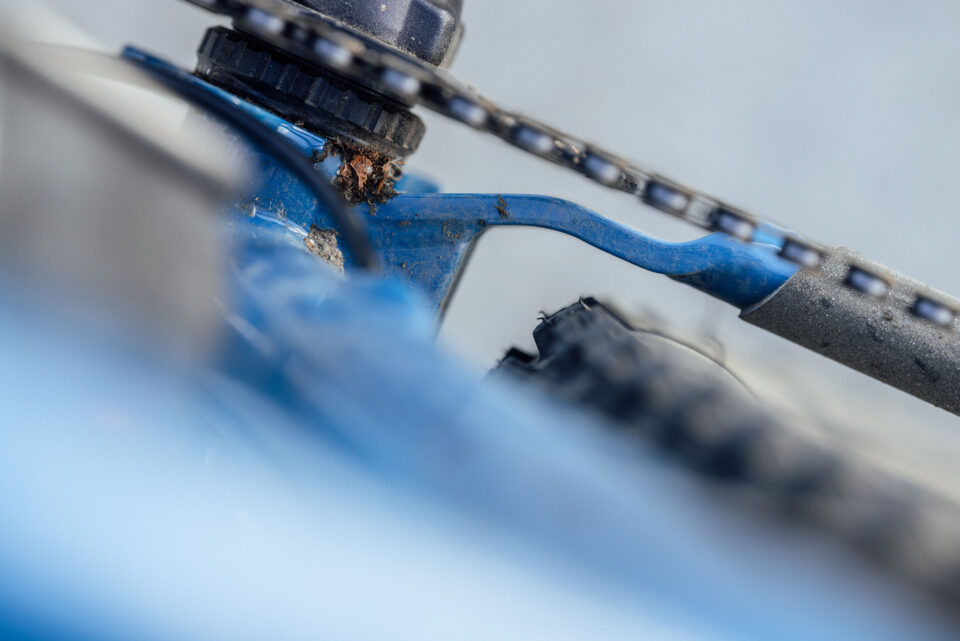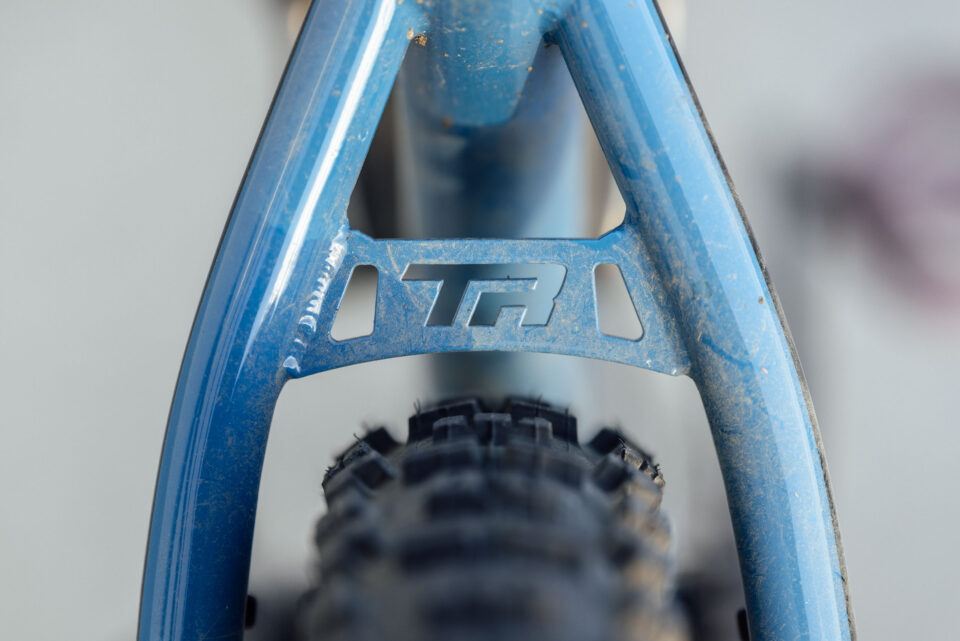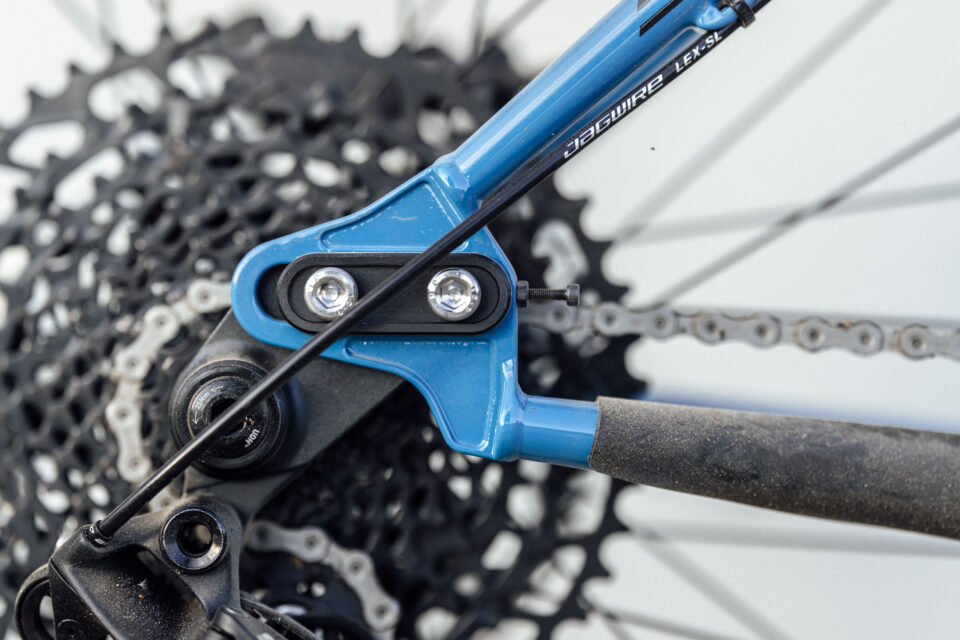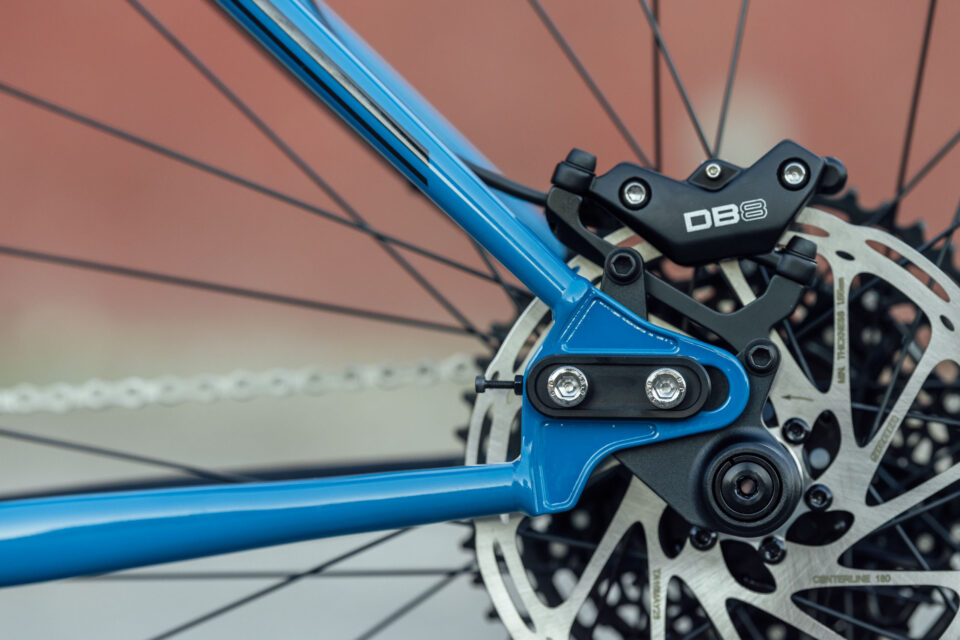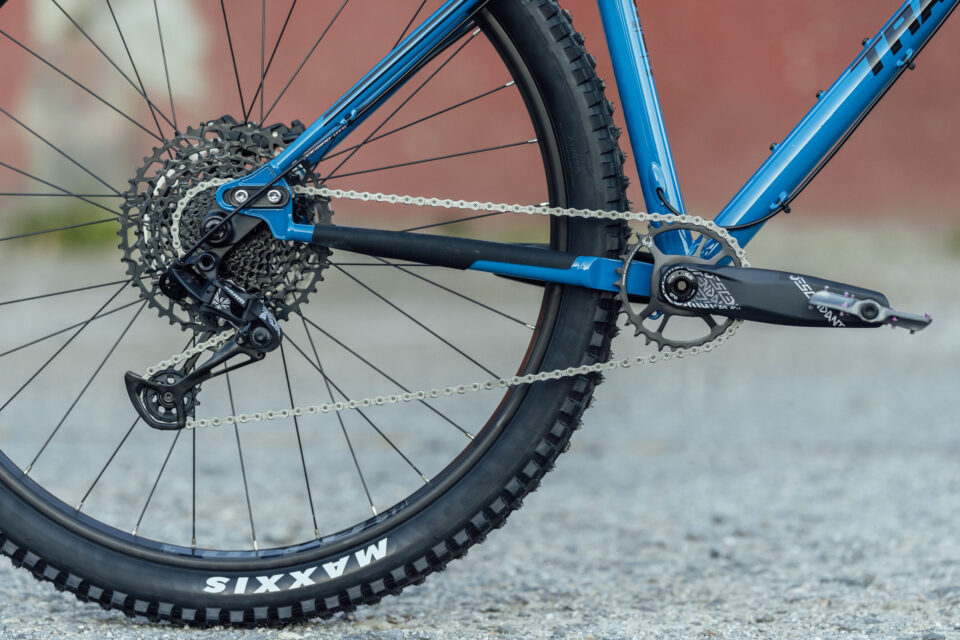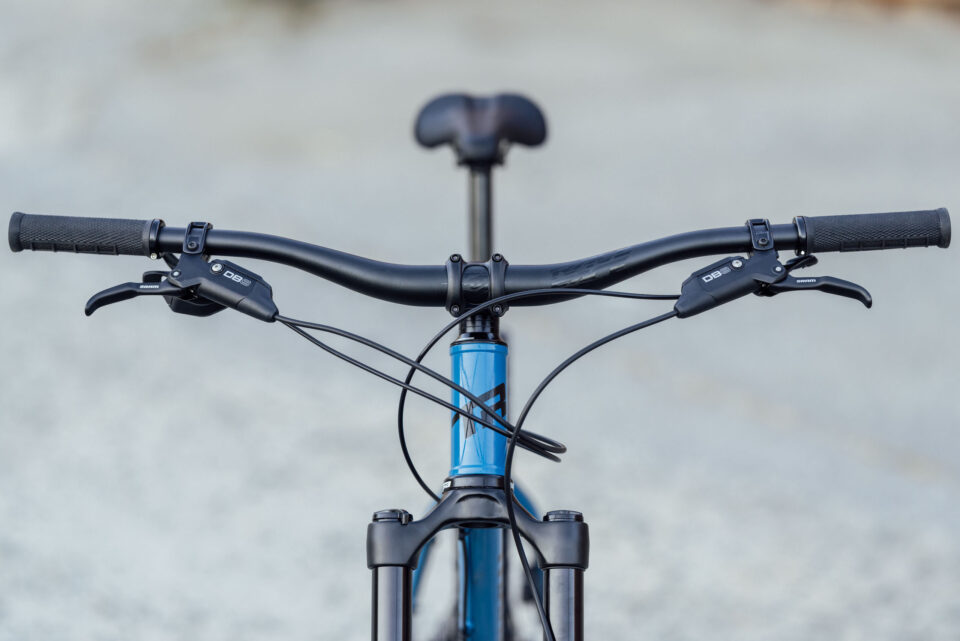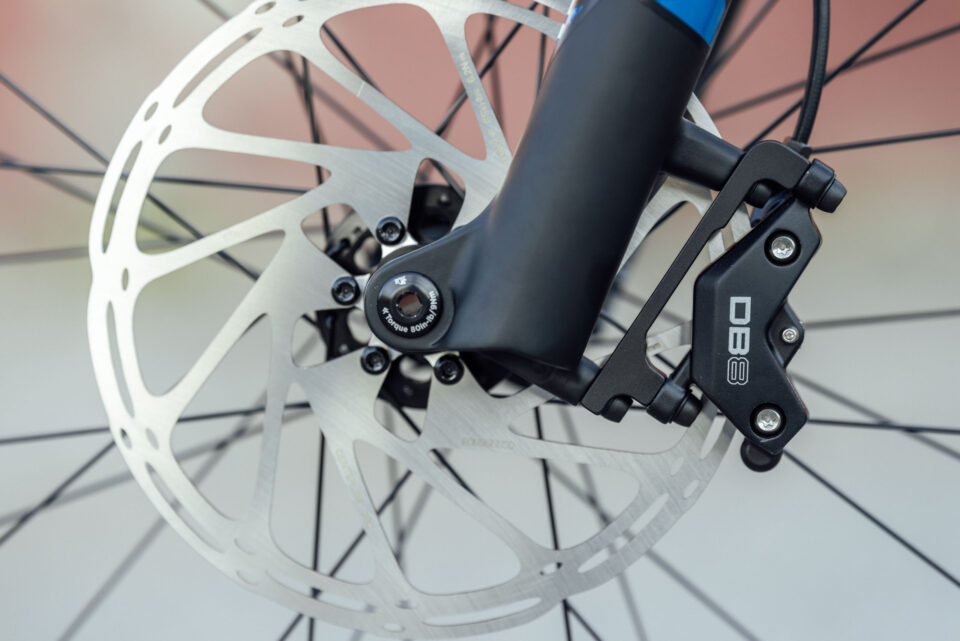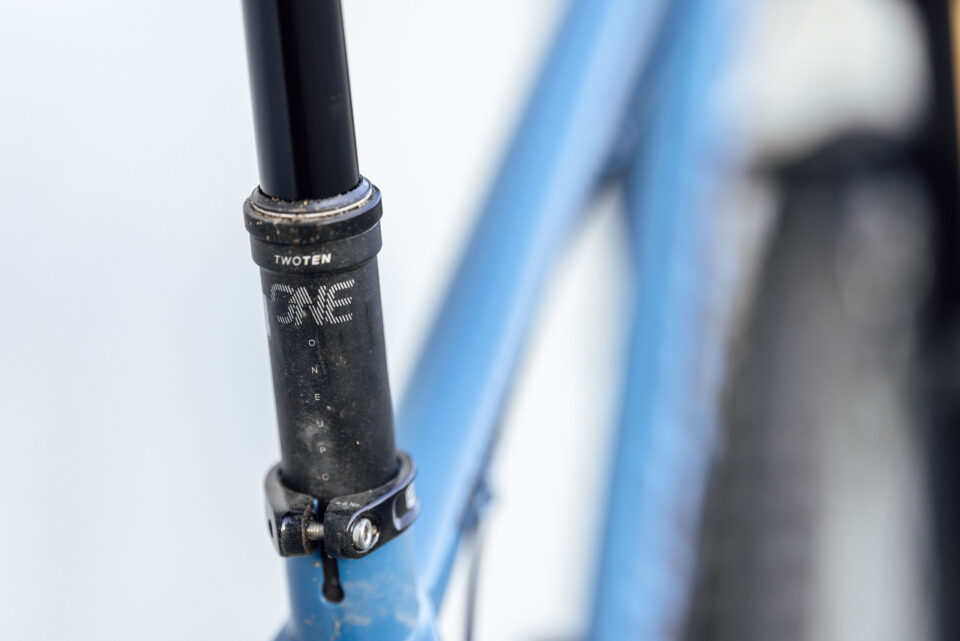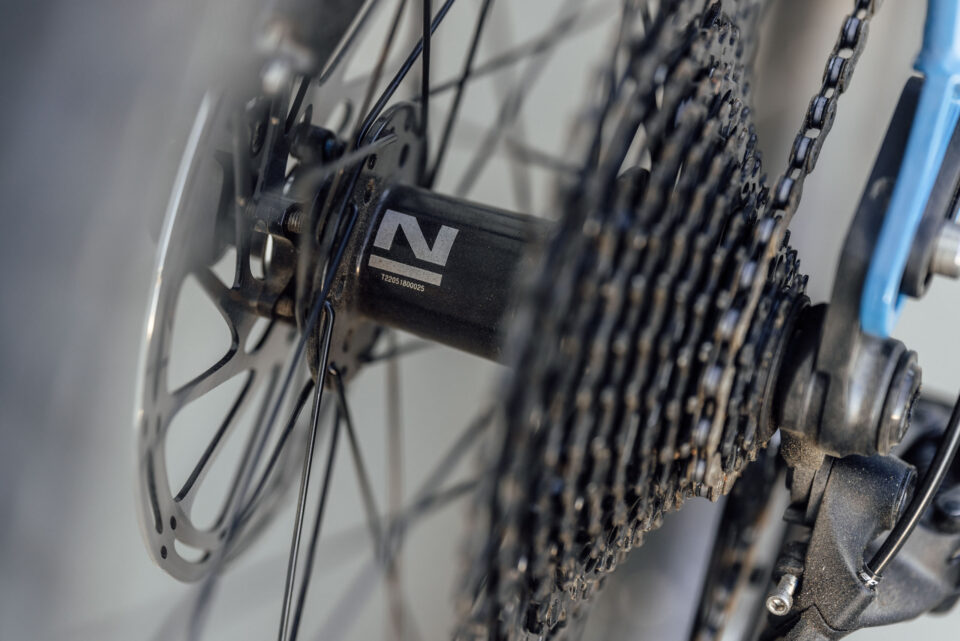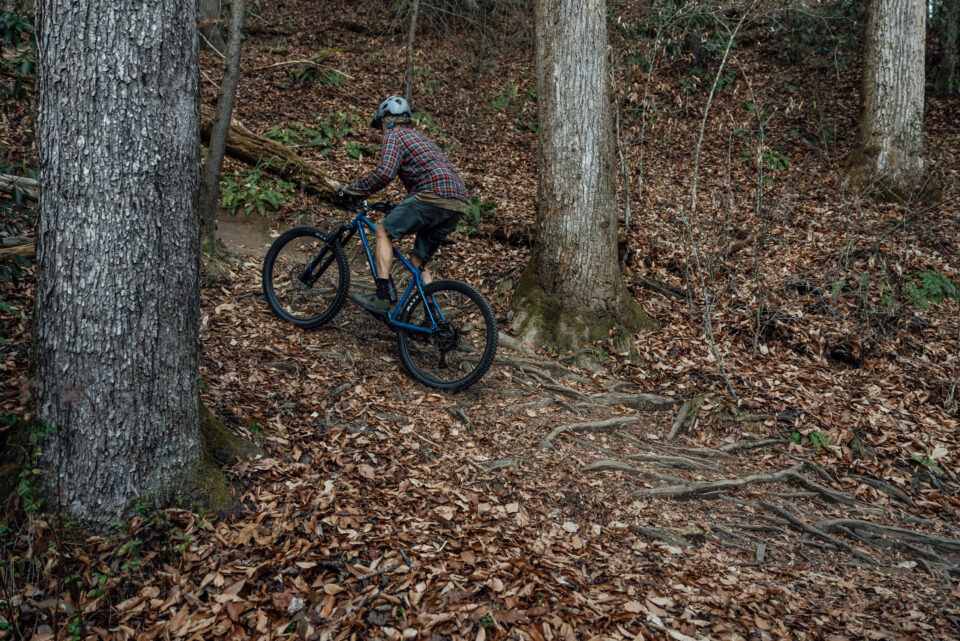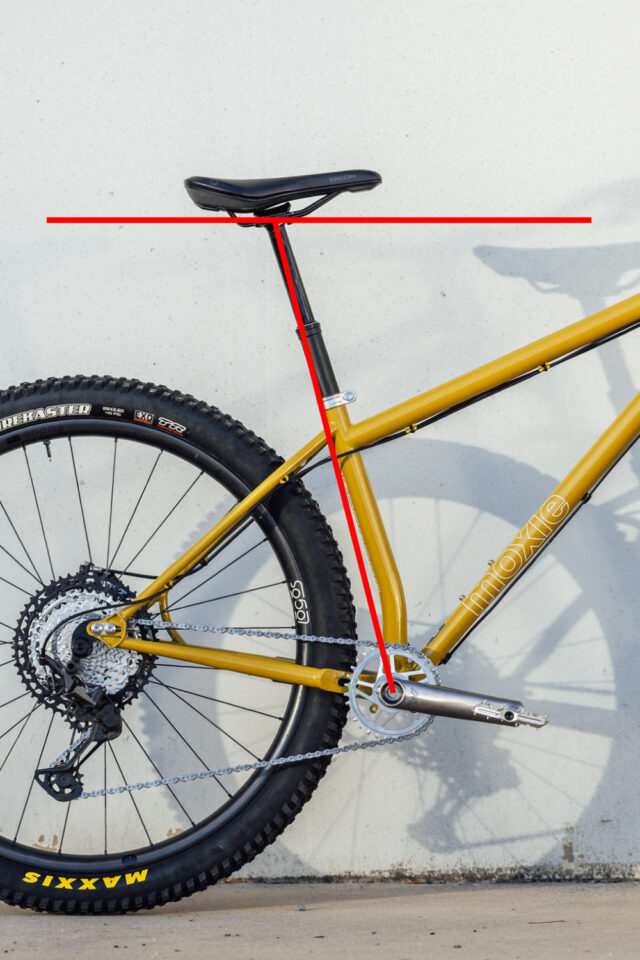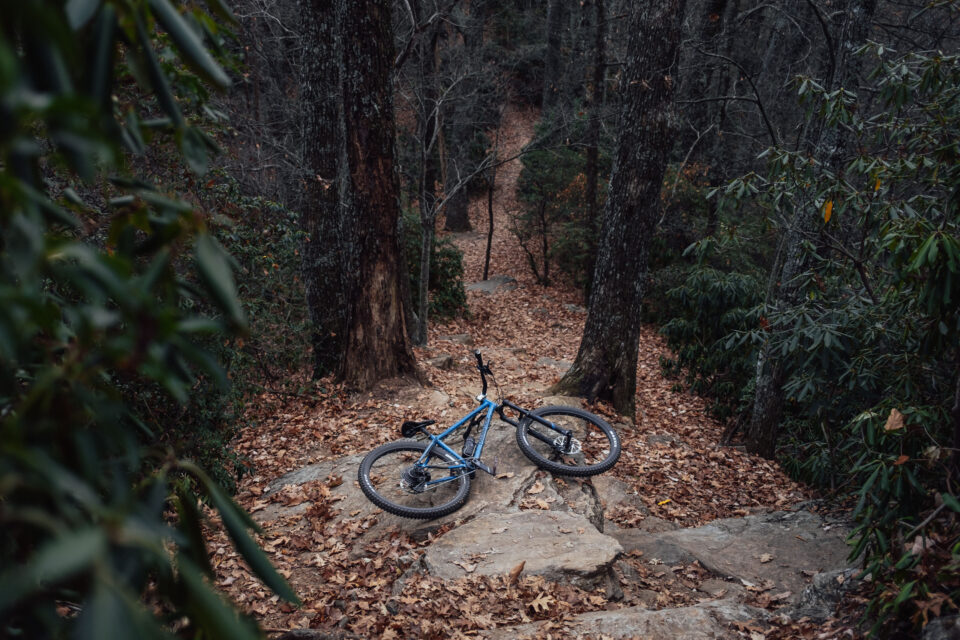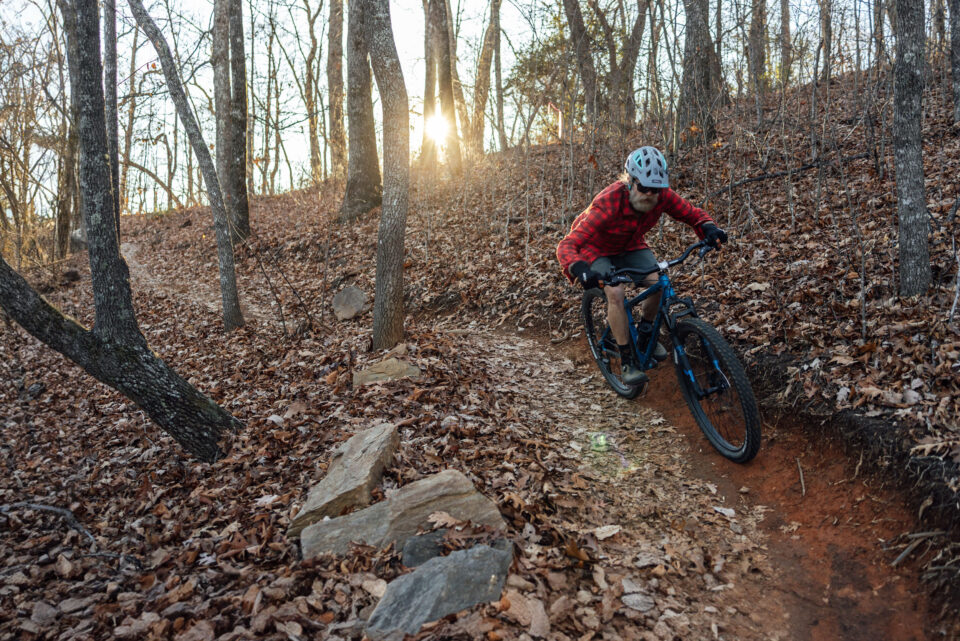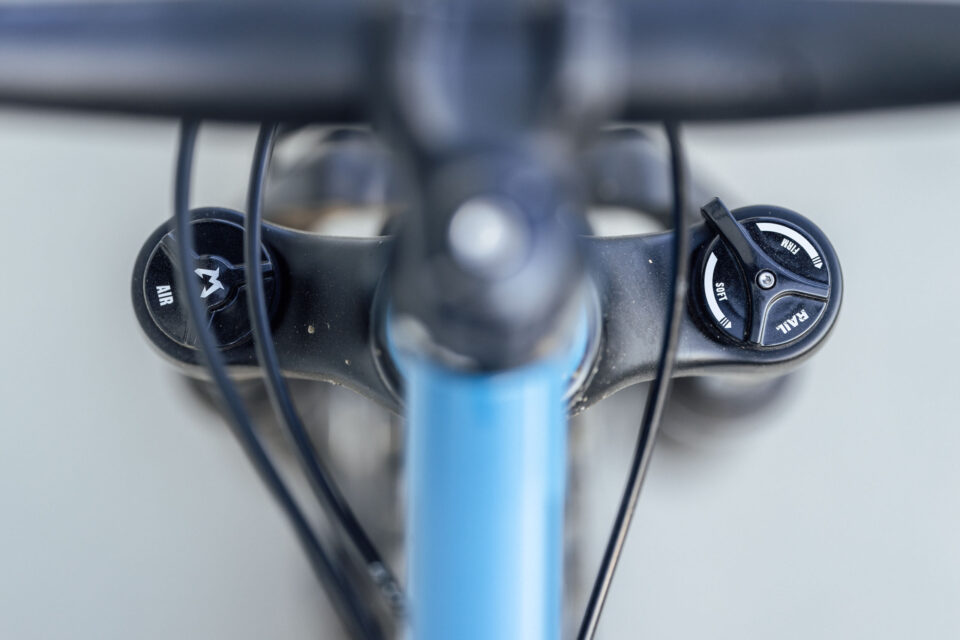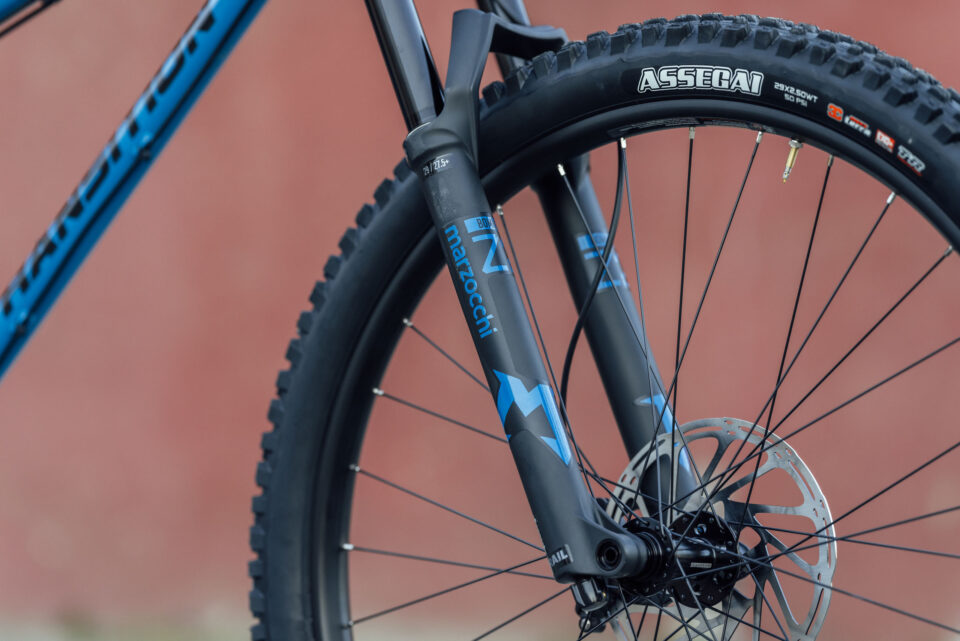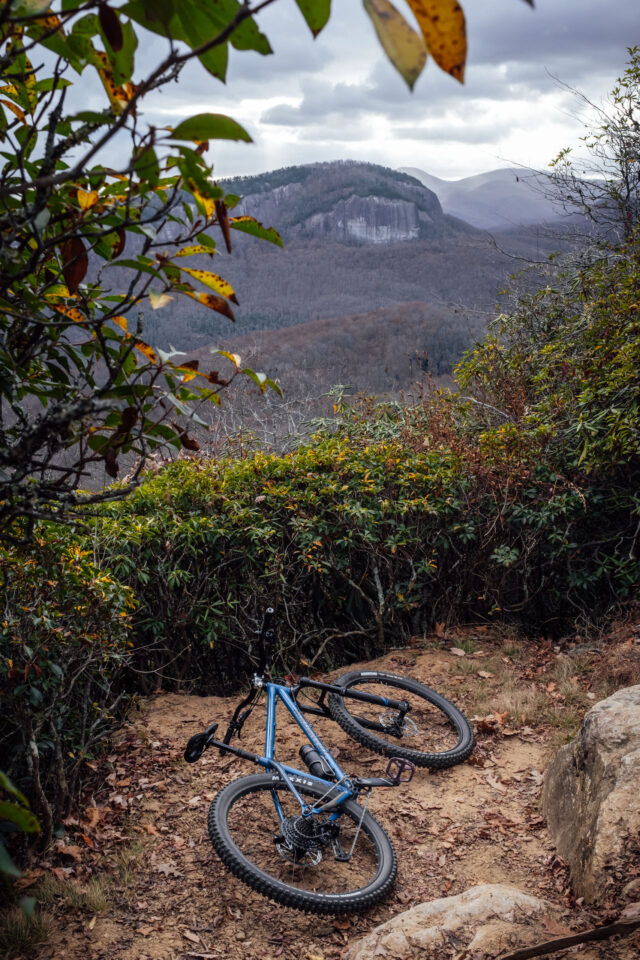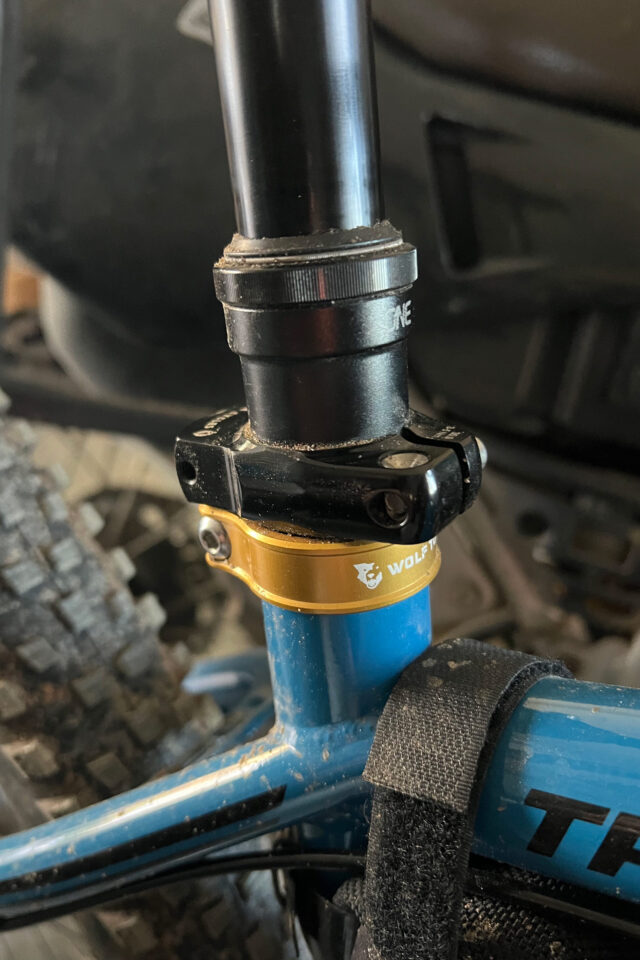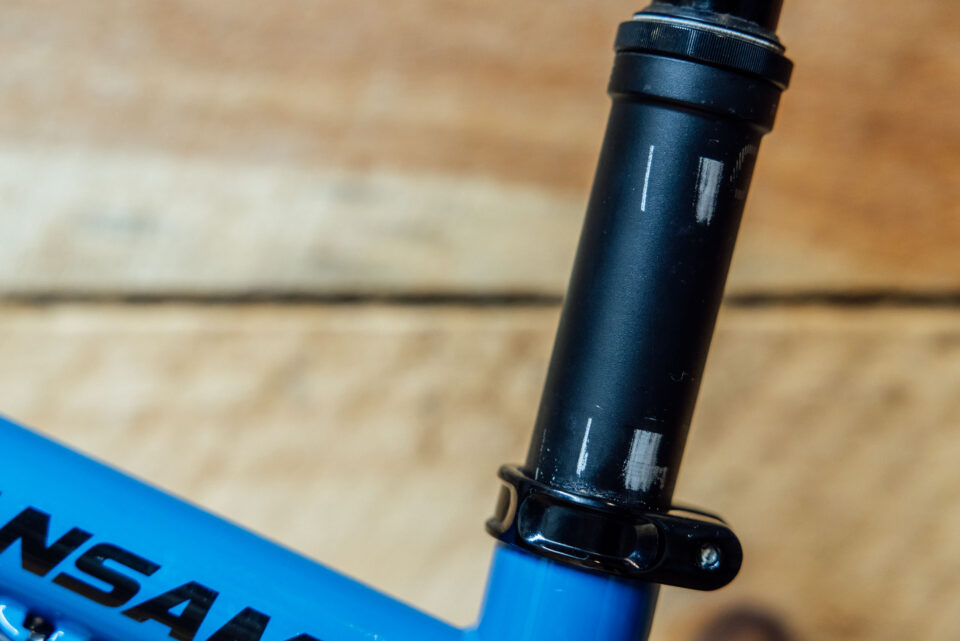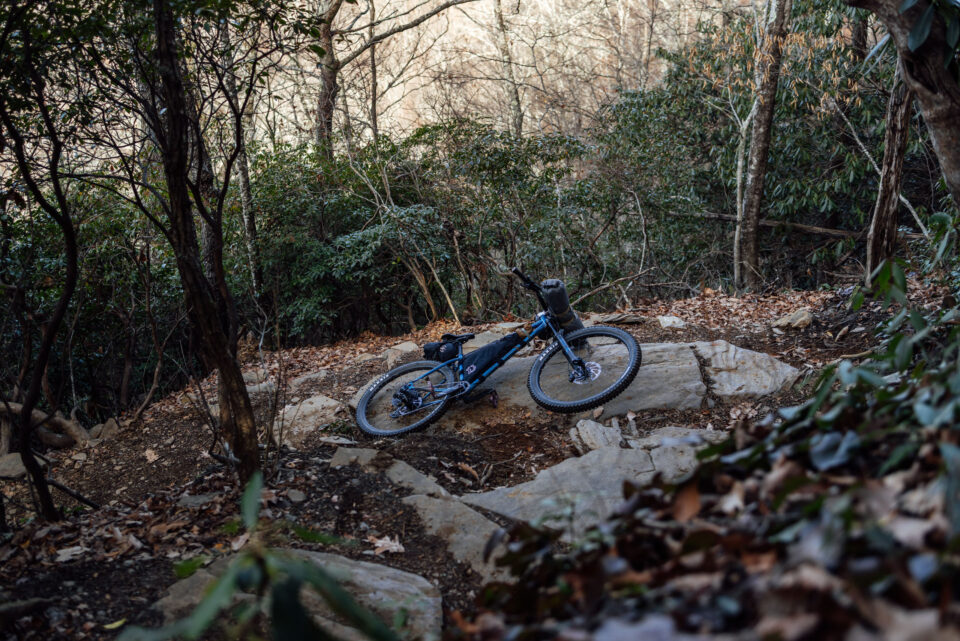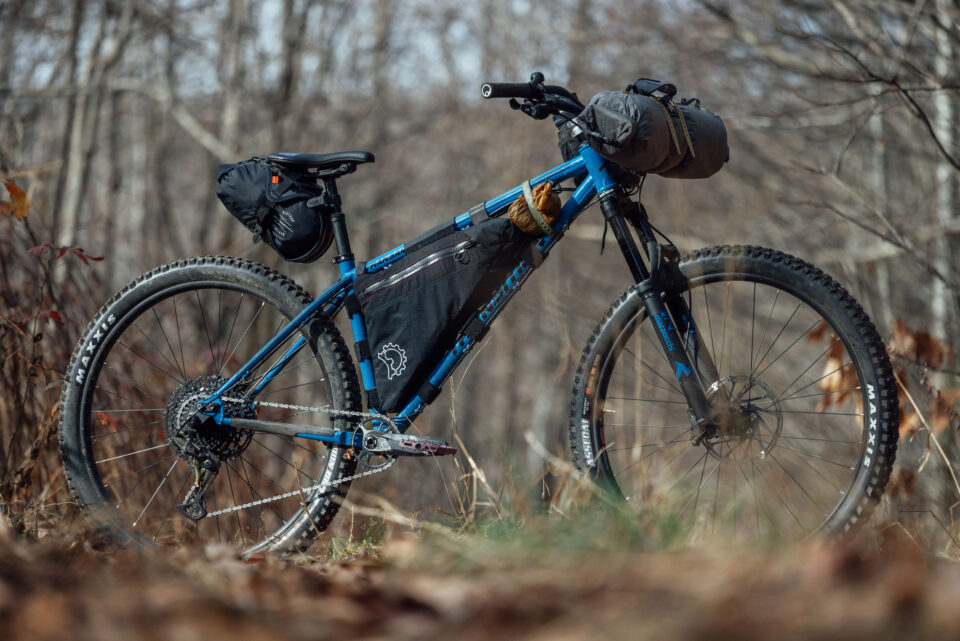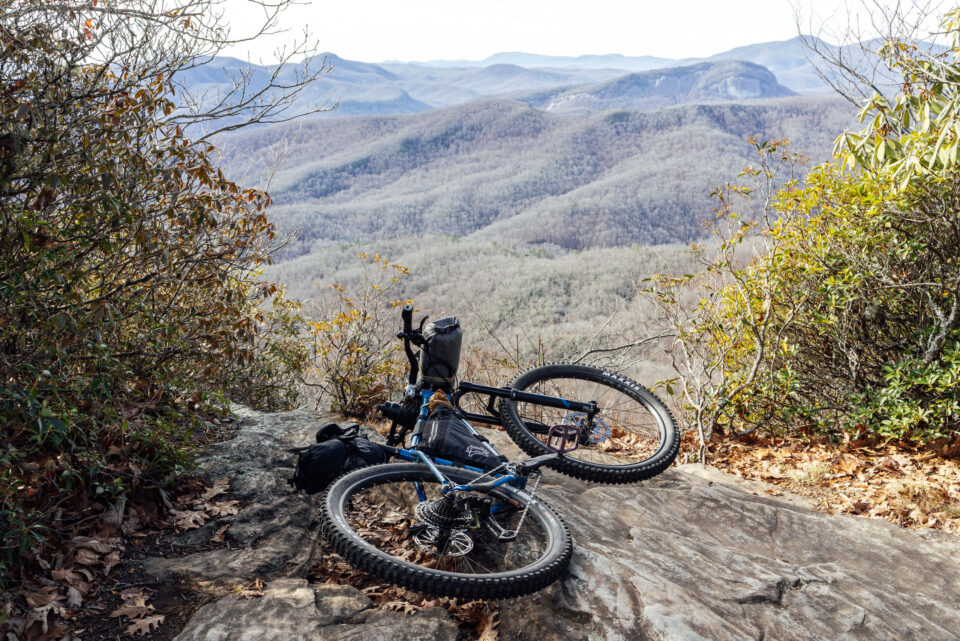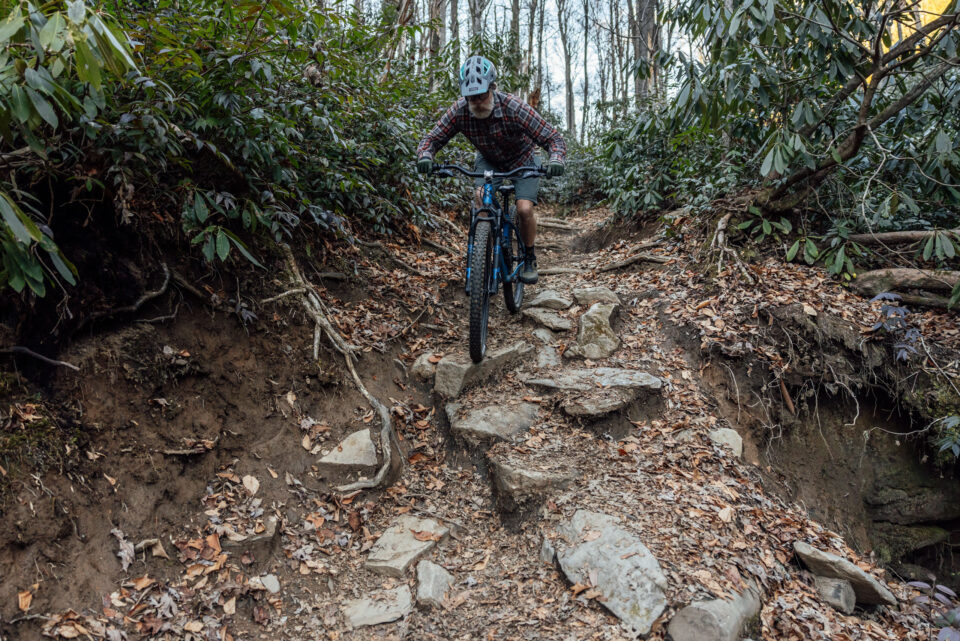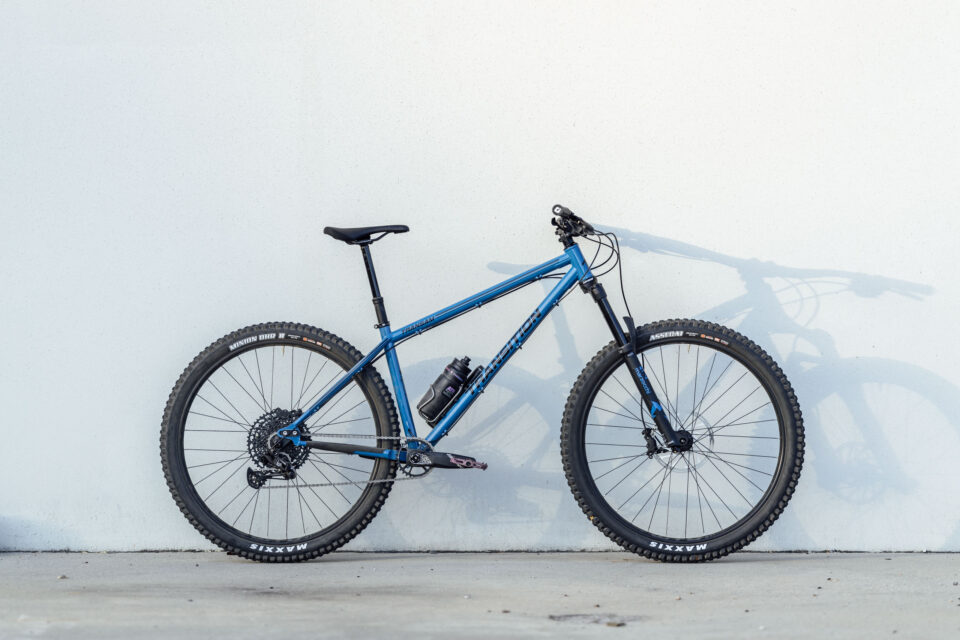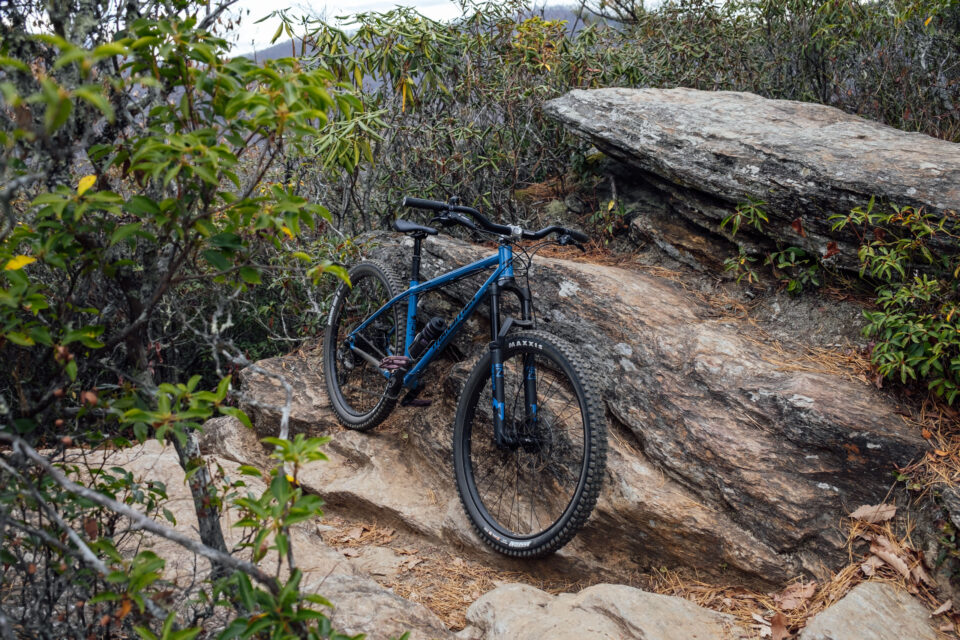2024 Transition TransAM Review: Shiny Things
Share This
The limited re-release 2024 Transition TransAM was announced in early November with modernized geometry, a revamped steel frame, sliding dropouts, and a couple of slick paint jobs. Logan’s been testing one for a couple months and reports back with a full review after trail riding and bikepacking with it around Pisgah National Forest. Find it here…
I can barely recall sitting on the edge of a movie theater seat at the age of four, legs dangling, captivated by the flickering scenes of the original Star Wars on the big screen. According to my dad, I didn’t blink once throughout the entirety of the highest-grossing movie of 1977. I was probably a little too young to see the second-biggest blockbuster that year, although Smokey and the Bandit was clearly on my radar. The star of that movie, the gold-trimmed black T-top 1977 Pontiac Firebird Trans Am, was my dream machine, and I had a 1:64 scale die-cast Matchbox version to prove it.
I’m pretty sure I remember pitting the Bandit Trans Am against my Star Wars figures in all-out toy war. I also think I blew them all up with cherry bombs at a later date, which was probably about the same time I got a Huffy BMX bike and lost interest in toys altogether. I was reminded of all this as several bike shop buddies got all giddy when they heard about the 2024 Transition TransAM. It seemed to suddenly be the next hot dream machine of middle-aged bike nerds. I had to get one to try it out and see if it lived up to the hype.
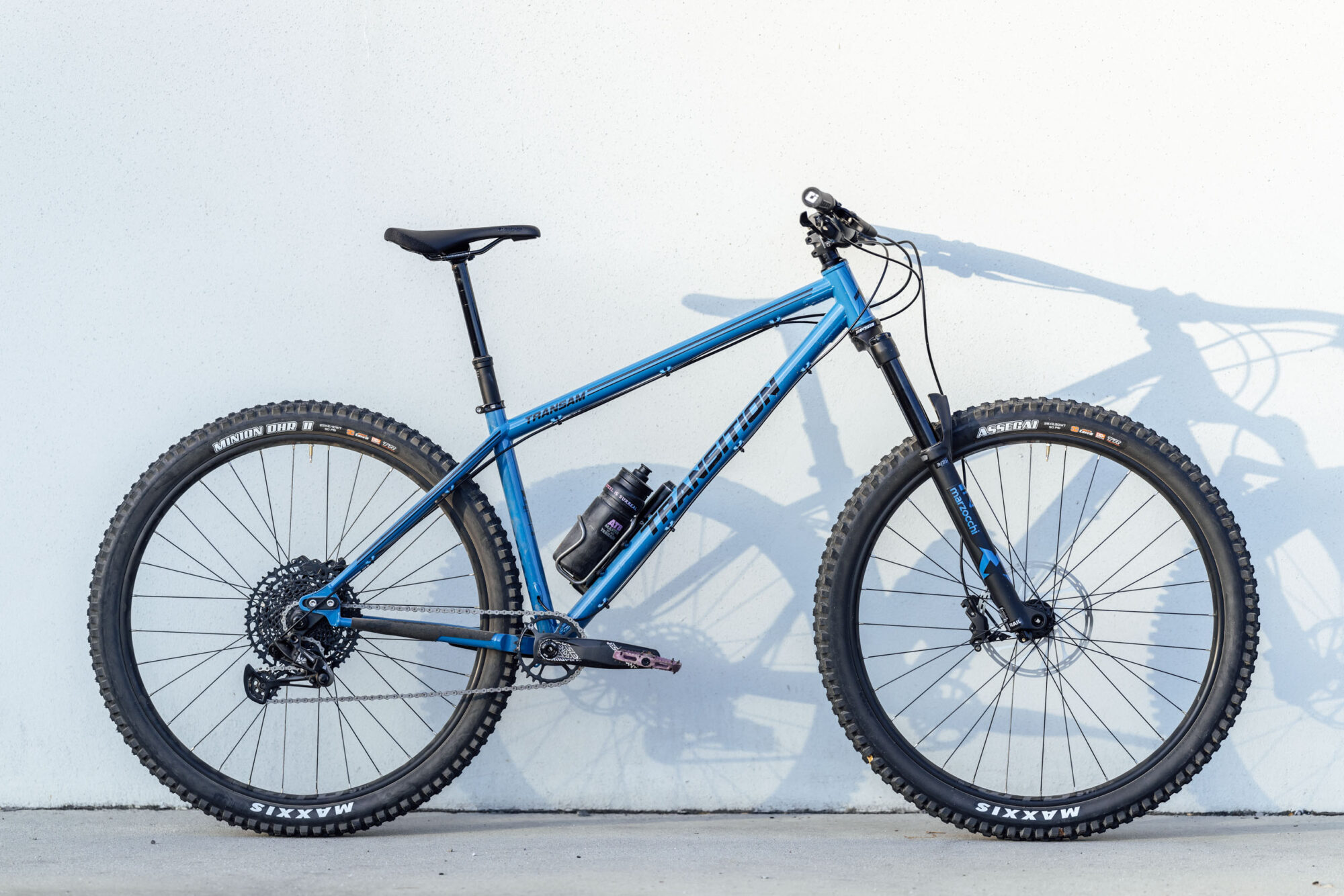
Nostalgia and shiny things aside, it was good to see a mainstream bike brand—especially one that’s focused on carbon full-suspension bikes—go back to the basics with a new steel hardtail. Is it just me, or are good hardtails becoming increasingly hard to find? I guess I should specify that I’m mainly referring to steel hardtails, particularly readily available ones. Don’t get me wrong, there are some great hardtails out there from the likes of Esker, Cotic, Pipedream, Surly, and others, but the list is always more finite than I expect when I start poking around for options. The worst is hearing when a company nixes a hardtail from their lineup. The Salsa El Mariachi and Why/Revel S7 spring to mind, although I think I’m missing some others that cut deep. Nowadays, the release of a new hardtail, particularly a steel one, is something to celebrate. The 2024 Transition TransAM was one such bike. We were certainly interested in it around here, and as mentioned, it created quite a buzz at my local bike shop. Several folks even ordered one before seeing it in person.
The 2024 Transition TransAM Frame
Originally released in 2009 as a 26er, the TransAM (short for Transition All Mountain) was the Bellingham, Washington-based company’s only hardtail. It was rereleased as a 29er in 2011 and then the brand put it on a seven-year hiatus a few years later. It was all but forgotten and long overdue for a refresh by the time they released the 2024 model in November. Still, Transition reported that the latest iteration of their trail hardtail is only back in the lineup for a limited time, which may have helped the hype factor—the ol’ get it while you can hook. That said, Transition told me they were exploring whether or not they’ll continue to offer the TransAm after this production run. “It wasn’t our original plan, but it’s been awesome to see so many people stoked about a bike that is so simple and that we still hold near and dear to our hearts,” said Lars Sternburg, Transition’s product marketing lead.
The 2024 Transition TransAM has a lot going for it besides the name and sweet finish options—shiny chrome or blue, as I tested. It also has a nice-looking straight-tubed steel frame, an aesthetic I prefer over curved tubes. The frame is made in Taiwan from a fairly standard 4130 chromoly tubeset with a 1.2/0.9/0.6/0.9mm thick top tube, a 1.1/0.6/0.9 mm thick down tube, and a straight-gauge 4130 rear triangle. You might call that a quad-butted top tube and a triple-butted down tube, but that depends on who you ask and whether you’re counting the number of different wall thicknesses or the number of changes in wall thickness.
Either way, it seems like a relatively conventional tubeset for a steel hardtail, although the yoke is different from anything I’ve seen. Transition used a formed steel plate on the drive side and plate steel bent in the shape of a rectangular box to join it with the non-drive stay and the bottom bracket. It looks like a solid block of metal, even though it’s hollow. Transition mentioned that they went in this direction to avoid additional costs and keep the price low.
FRAME SPECIFICATIONS
- FRONT TRAVEL: 150mm
- WHEEL SIZE: 29″ F&R
- SIZES: SM, MD, LG, XL
- COLORS: Chrome, Cascade Blue
- FRAME MATERIAL: Chromoly Steel, 4130
- FORK AXLE TO CROWN: 574mm (Excludes Headset)
- FORK OFFSET: 44mm
- HEADSET (TOP): ZS44
- HEADSET (BOTTOM): EC44
- BB SHELL: 73mm BSA Thread
- CHAINLINE: 52-55mm
- REAR BRAKE MOUNT: 160mm IS, Max Rotor Size 223mm
- DERAILLEUR HANGER: SRAM UDH (T-Type Direct Mount)
- REAR AXLE: Transition Axle For UDH, 12mm x 148mm Spacing
- ISCG TABS: ISCG05
- SEATPOST DIAMETER: 30.9mm
- SEAT CLAMP: 34.9mm
- MAX SEATPOST INSERTION: Small 250mm | Medium 280mm | Large 320mm | X-Large 350mm
- MAX CHAINRING SIZE: 34T Single Ring
- MAX TIRE SIZE: 29 x 2.5
Another selling point with the TransAm frame is the sliding dropouts. These, of course, add singlespeed capability and versatility by providing 12mm of adjustment to tweak the chainstay length between 425 and 437mm. The dropouts are fully custom to the TransAm and are designed to accommodate a Universal Derailleur Hanger (UDH) if someone wants to build theirs with the SRAM T-Type transmission. The dropout hanger system has a pretty simple design that uses two M8 x 18mm bolts that pass through a machined aluminum plate and thread into the holes on the aluminum UDH plates. I adjusted the sliders several times during the test period and was pretty impressed with them. They seem well-built and are easy to use. It’s also worth noting that they offer replacement parts on their support page.
Lastly, the new TransAM seems fairly well priced, particularly as a frameset, which you can get for $800. I tried the complete build that retails for $2,600. Let’s take a look at that before digging into how it rides.
- FORK: Marzocchi Z2 (150mm)
- HEADSET: FSA No.10/7B/44
- STEM: RaceFace Aeffect R (40mm)
- HANDLEBAR: RaceFace Chester 35 SM/MD(780×20) LG/XL(780×35)
- GRIPS: ODI Elite Flow Lock-On
- SADDLE: SDG Bel Air 3
- SEATPOST: OneUp Dropper Post SM(150mm) MD(180mm) LG/XL(210mm)
- BRAKES: SRAM DB8
- ROTORS: SRAM Centerline (200/180mm)
- SHIFTER: SRAM NX Eagle MMX
- DERAILLEUR: SRAM NX Eagle
- CASSETTE: SRAM PG 1230 (11-50t)
- CHAIN: SRAM NX Eagle
- CRANK: SRAM Descendent 6k DUB (170mm x 30t)
- RIMS: WTB ST 130
- SPOKES: Pillar Double Butted
- HUBS TIRE/FRONT: Novatech D791SB/D902SB
- TIRE/FRONT: Maxxis Assegai 3C EXO+ (2.5)
- TIRE/REAR: Maxxis Minion DHRII 3C EXO+ (2.4)
- WEIGHT: 33.0 lbs / 14.97 kg (Size MD)

How does it feel?
Straight away, this bike felt abnormally heavy. Sure enough, when I popped it on my scale, the size large complete weighed 33.03 pounds (14.98 kilograms) out of the box without pedals. Much of the extra blubber is in the build kit. It has heavy everything, from the bottom-shelf NX drivetrain to the wheels to the cockpit components. That said, for those starting from scratch and looking to upgrade along the way, a couple of keeper components on the complete build listed above might make it worth the investment. For example, I liked the DB8 brakes. SRAM’s new mineral oil four-piston stoppers use mineral oil instead of DOT fluid, which is cleaner. And they’re much more powerful than I expected. I also liked the fact that Transition specced it with a OneUp V2 seat post, one of only a couple of options that I trust. The Marzocchi Z2 is also decently credible, although it might not be the best choice for this bike, which I’ll talk more about later. It’s a simple fork, but it generally feels pretty good, and it’s reliable and doesn’t require much maintenance. Otherwise, I’d personally rather build the TransAm from scratch, ditching the heavy wheels, cockpit components—including the uncomfortable SG saddle—and brick-like NX drivetrain. Oh yeah, the FSA headset bearing went bad on me toward the end of the review period too.
That heaviness is also a contributor to the TransAm’s sluggish ride. I wouldn’t say that it feels extremely slow in the grand scheme of hardtails, but it certainly seems relatively sloth-like when churning on flat terrain and steady medium-pitch climbs. I think this could be corrected with lighter and faster tires—the Minion DHRII is probably a little too much as a rear tire, and the Assegai is notoriously slow, although I love it as a confidence-boosting front tire. Lighter wheels and a more svelte drivetrain would also help.
Geometry and Ride Impressions
For someone interested in a more progressive and playful trail hardtail, the TransAM’s angles and measurements look great on paper. Going into it, I had a pretty good idea of what it would feel like, but there were a few surprises along the way. The first curveball I found was how well the Transition TransAm performed while pedaling on engaging singletrack and more technical climbs. The torpid ride it presented on the flats and moderate-grade climbs seemed to vanish when the bike was pushed on challenging and active trails. The steep seat tube and relatively high bottom bracket allowed me to attack technical sections and churn over roots and rocks, particularly when climbing.
| Size | SM | MD | LG | XL |
|---|---|---|---|---|
| REACH | 430 | 460 | 485 | 510 |
| STACK | 641 | 641 | 646 | 655 |
| EFFECTIVE TT LENGTH | 584 | 614 | 640 | 667 |
| SEAT TUBE LENGTH | 370 | 400 | 430 | 460 |
| EFFECTIVE ST ANGLE | 76.5° | 76.5° | 76.5° | 76.5° |
| HEAD TUBE LENGTH | 105 | 105 | 110 | 120 |
| HEAD TUBE ANGLE | 64.0° | 64.0° | 64.0° | 64.0° |
| CHAINSTAY LENGTH | 425-437 | 425-437 | 425-437 | 425-437 |
| WHEELBASE (425mm CS) | 1187 | 1219 | 1246 | 1276 |
| BOTTOM BRACKET DROP | 50 | 50 | 50 | 50 |
| ESTIMATED BB HEIGHT | 320 | 320 | 320 | 320 |
| STAND OVER HEIGHT | 662 | 667 | 670 | 677 |
| FORK OFFSET | 44 | 44 | 44 | 44 |
| SEAT POST INSERTION | 250 | 280 | 320 | 350 |
In and Out of the Saddle
It also does pretty well when climbing out of the saddle, maintaining traction and balance, which is a good sign for prospective singlespeeders. I ended up pushing the wheel all the way to the rear in the sliding dropout, which gives it a 437mm chainstay length, and, in my experience, added traction and a much more stable ride while climbing and descending.
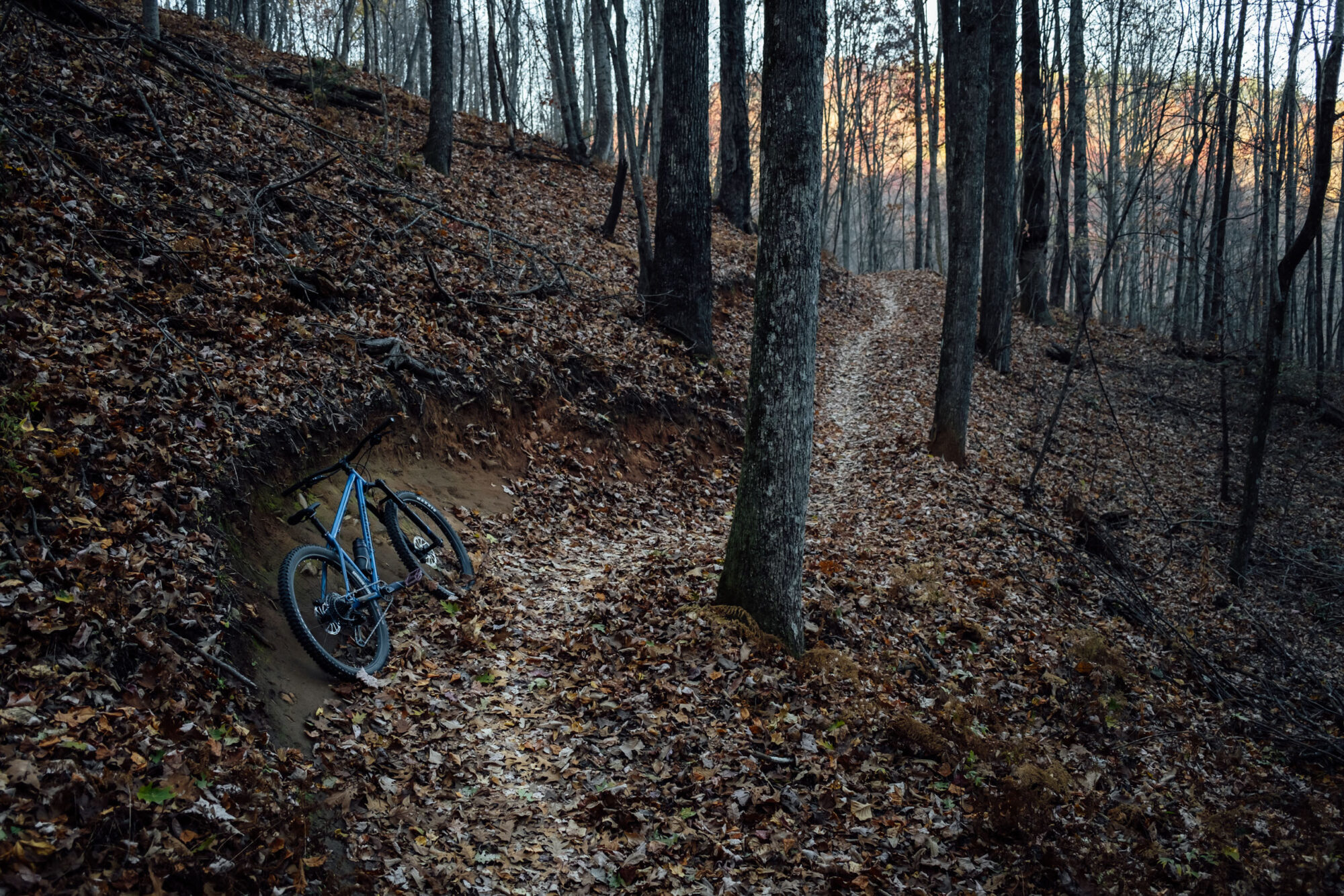
On the flip side, one negative characteristic stood out to me while pedaling in the saddle. The steep seat tube seemed to accentuate bumps, exhibiting something like a catapult effect and making the ride feel rougher and slightly more taxing while seated on rough trails. Case in point, The TransAm has a very steep seat tube angle (STA). At 76.5°, it doesn’t seem overtly steep on paper, especially when compared to the 77.5° STA specced on the Kona Honzo ESD and the Pipedream Moxie, a bike I rode alongside the TransAm. However, since I have long legs, the effective STA is vastly different on the Moxie, given the curved seat tube. The TransAm remains at 76.5° since it has a straight seat tube, no matter how long your seat post is. In my opinion, hardtails don’t need seat tubes this steep, especially for tall people.
Going Down
Descending is where the analysis of the 2024 Transition TransAm gets interesting and brings a few things to light. It wasn’t what I expected, and took me a while to fully get it, to be honest. One reason for that is this was the first time I’ve ridden a 150mm travel hardtail. My first impression was that it didn’t feel nearly as confident on steep and technical descents as two other comparable hardtails I’d ridden recently, the 120mm Pipedream Sirius S5 and the 140mm Pipedream Moxie. All three have similar geometry, so the obvious point of differentiation is the longer fork. More travel translates to more variation in geometry and ultimately more disequilibrium when the geometry shifts from slacker to steeper instead of remaining at a near constant. Eventually, I got used to it, but I still think The TransAm works better on trails that are fast with the occasional big hit. Think fast and loamy trails of the Pacific Northwest with one-off bigger ledges, jumps, and moves.
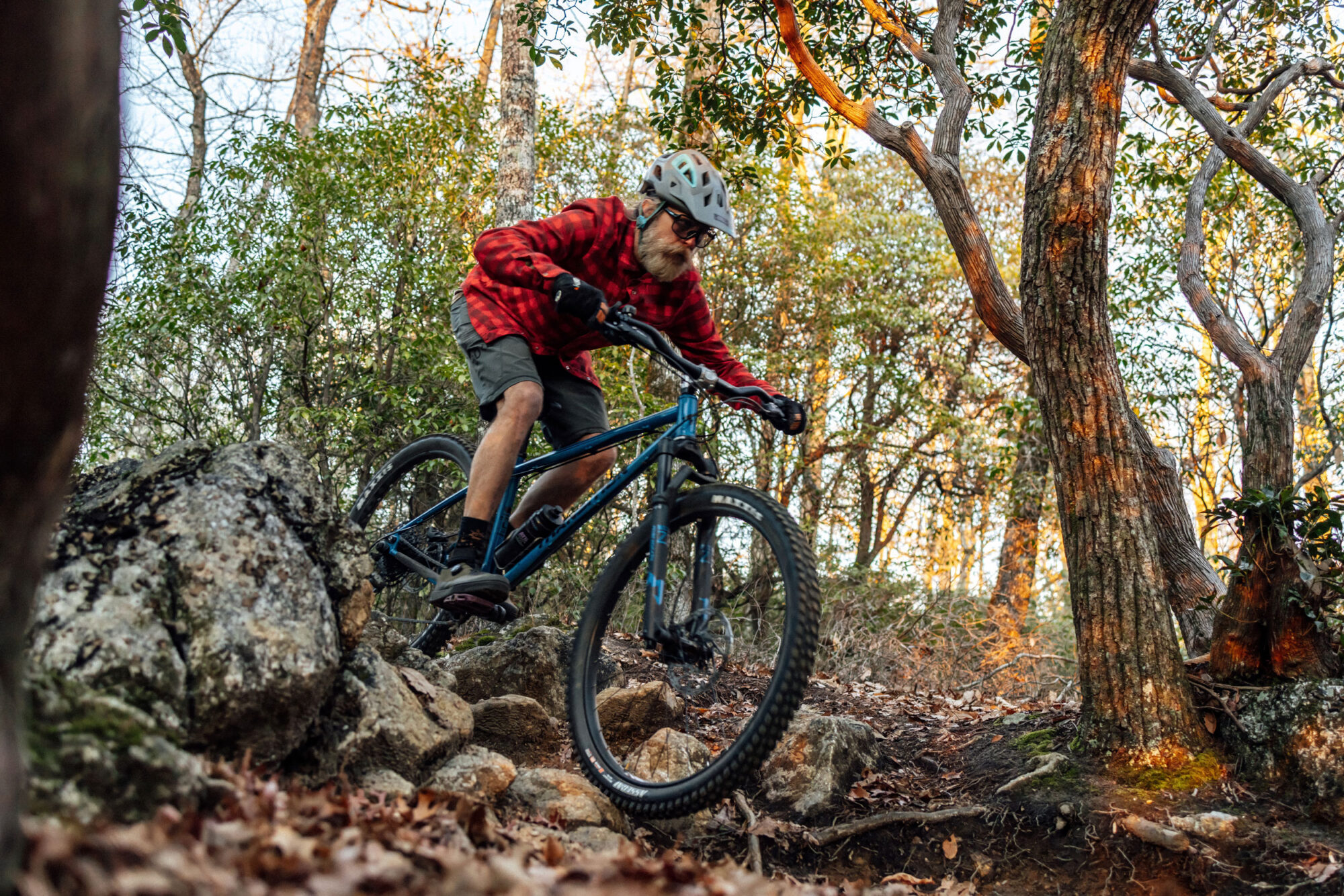
Another contributor to TransAm’s apprehensive disposition has to do with the fork. I tooled around with the Marzocchi Z2 a little bit, but it’s important to consider it’s structurally comparable to the Fox 34 and Rockshox Pike, both of which have the same 34mm diameter stanchions and max out at 140mm of travel. I generally had the impression that this fork felt a little weak-kneed at 150mm and that Transition should have specced it with the 36mm-stanchion Z1. I got the best results by dialing up the low-speed compression (firmness) of the Z2, which made it feel a little more solid. I could have also tweaked the volume spacers to better set it up for the TransAm, but I still think The TransAm needs a more stout fork in the long run. There’s a reason Lyrics and Fox 36s are specced on 150mm+ travel bikes.
But having said all that, I digress. I personally think 150mm of fork travel is too much for a hardtail in general. That range of variability in the front with a static rear end is excessive, and I would have preferred the TransAm to be designed around a 130-140mm fork. You could outfit it with a 140mm fork, but doing so might throw off the geometry too much. The seat tube angle is already a tad steep, and it would be even steeper with a shorter fork. This is what makes bikes like the Pipedream S5/S6 so interesting to me—a slack and aggressive geometry built for 100-120mm short-travel forks. Obviously, many people like longer 150-160mm hardtails, so take this with a grain of salt, as it’s my personal preference.
Handling
When it comes to cornering and maneuvering on the trail, the Transition TransAm handles quite well. Similar to the Smuggler I reviewed, it has a fun factor that comes to life when cornering quickly and carving up trails at higher speeds. However, it’s not quite as playful as I expected when jumps and jibs are in the mix. It feels rather grounded and planted, which might be partly attributed to its heavyweight build. And, as mentioned, I ultimately moved the axle all the way rearward in the sliders, which I found helped the TransAm’s confidence on steep descents and improved traction overall but toned down the bike’s party vibe.
Frame Feel
As for the feel of the TransAm’s steel frame, things get a little more complicated here. My first impression (which still holds true) was that the TransAm is a little harsher than most of the steel hardtails I’ve ridden. But there are caveats. The harshness is more evident on ledges, drops, and hard impacts than it is on small bumps and vibrations. It goes without saying that you can feel bigger hits on all hardtails, but some steel hardtails do a much better job at soaking in and displacing those jarring effects—something you can feel after an extended descent when these shocks and knocks compound. I wonder if the TransAM’s harsh bite on these types of impacts might stem from the overbuilt yoke. It actually feels pretty good when pedaling along on smaller bumps, as if the tubeset handles these types of vibrations a little better. This may be due in part to the 30.9mm seatpost spec. I usually prefer 31.6 based on my parts collection, but I think there’s something to be said for using a smaller seat tube in this instance.
Slip Up
That brings me to a bigger issue I discovered on the Transition TransAm, at least with the frame I tested. When I first reassembled it from the box, I torqued everything down and went on a short ride to one of my favorite spots to get some photos. I immediately noticed that the seatpost slipped down several millimeters. I thought I may have forgotten to tighten it completely, so I adjusted it when I got home, torquing it to about 5 or 6nm. On the first ride after that, it slipped again. I’ve had slipping seat posts in the past, so I knew the drill. I cleaned out the seat tube and added some carbon paste, then re-torqued the collar to about 7nm. However, it slipped yet again. I asked a friend who was an early adopter of the TransAm, and he reported having had the same problem; he also mentioned that he heard of a couple of others with the same issue. At that point, he had tried a Hope Seatpost clamp and carbon paste with no luck and ultimately had to tighten the seat post collar to 7nm and place a Salsa 30.9mm Post Lock above that to further secure it and prevent it from slipping.
I was able to secure mine by coating the interior with a little carbon paste and significantly over-torquing the collar bolt. Somewhere around 10nm did the trick, but that’s a few newton meters over torque spec, which jeopardizes the collar/bolt and puts too much pressure on the dropper seat post. We wondered if the seat tube may be improperly sized, so we did some science. Digital calipers showed the inner diameter of the TransAm’s seat tube to be 31.05mm. We measured three other 30.9 bikes for comparison: the steel Surly Grappler, the Bassi Coyote, and the Salsa Cassidy. The steel Grappler measured 30.86mm at the top, the carbon Cassidy measured 31.03mm, and the Bassi was 30.91. These are tiny fractions, but perhaps it could be part of the issue. Another factor might be the ultra-steep STA, which theoretically transfers the rider’s weight almost directly downward. Note that I had this issue on the Pipedream Sirius S5 at first, but carbon paste and a Hope seatpost collar easily remedied it.
I asked Transition about it, and they mentioned that some of the earlier TransAms were shipped with a non-greased seatpost collar bolt and that greasing that bolt solved the issue. However, it still seems to me that there may be a more significant issue with at least a few of the new frames. I hope it was an isolated issue.
While Out Bikepacking
Considering the 2024 Transition TransAm’s geometry and sheet, a lot of folks might not think of it as a bikepacking bike. However, it’s a steel hardtail, meaning it’s inherently versatile by nature. The TransAm lacks any extra provisions, save a single pair of mounts on the downtube to hold a water bottle. I wish that it had more mounts in and under the triangle, as well as rack mounts, but it’s perfectly fine given the variety of bags and ways to mount things these days. I used the large Revelate Rifter, which fit the frame very well, although the long triangle left a void at the front; I ended up filling it by strapping in a rain jacket, which worked well. You can find the full pack list I used on a trip when these photos were taken here.

All of the ride qualities noted above remained the same when it was loaded up. In the end, I think a 150mm fork is too much for bikepacking on a hardtail. However, having some additional weight on the bike helped stabilize the fork and tone it down a little. All told, I thought the TransAm felt pretty good bikepacking on singletrack, particularly on more technical climbs and fast downhills. For the right person, I think it would make a great all-around steel trail bike that doubles as a bikepacking bike and triples as a singlespeed.
- Model/Size Tested: 2024 Transition TransAm (Large)
- Actual Weight: 33.03 pounds (14.98 kilograms)
- Place of Manufacture: Taiwan
- Price: $2,600
- Manufacturer’s Details: Transition Bikes
Pros
- Interesting geometry that’s impressively versatile
- Surprisingly good at pedaling active trails and climbing technical singletrack
- Well-positioned BB drop allows you to churn over roots and rocks
- Available as relatively inexpensive frame-only option
- Nice colors and straight-tube aesthetic
Cons
- Slipping seat post
- Heavy build kit with an expensive price tag
- No mounts under downtube or rack mounts
- Harsher than some other steel hardtails in the category
- Not as confident a descender as similar bikes, partially due to the fork
- Slow climber
Wrap Up
One common trait among all hardtails is that they’re never truly perfect. Reactions to new ones are often familiar to what I heard about the new 2024 Transition TransAM when it was announced: “Oooh, it has a sliding dropout and a 64-degree head tube angle. It looks exactly like what I’ve been waiting for.” But in the end, there’s always something you’d tweak or change if you had it exactly how you want it. That’s where custom bikes come in, but it’s also nice to have more readily available options with their own uniquenesses and strengths.
For the most part, I enjoyed my time with the TransAm. If I had it my way, it would have a slightly slacker seat tube, a few more mounts, and be built around a 140mm fork. Otherwise, it has a nice geometry that handles really well while going fast, charges up and over technical bits, and rewards an aggressive chin-over-stem riding style and a careful selection of lines. However, it’s not without cons. The complete build isn’t great, and I’d argue that it should be a $2,250 bike with its parts list. In addition, the frame has an acute harshness on ledges and more significant impacts, and the slipping seat post was a pretty big deal on my demo model. Still, I’m happy to see Transition put this out there, and I think it’s a bike many people will like.
If you have any questions about the 2024 Transition TransAM or how it compares to other bikes I’ve reviewed, feel free to leave them in the conversation below and I’ll be happy to answer.
Further Reading
Make sure to dig into these related articles for more info...
Please keep the conversation civil, constructive, and inclusive, or your comment will be removed.






